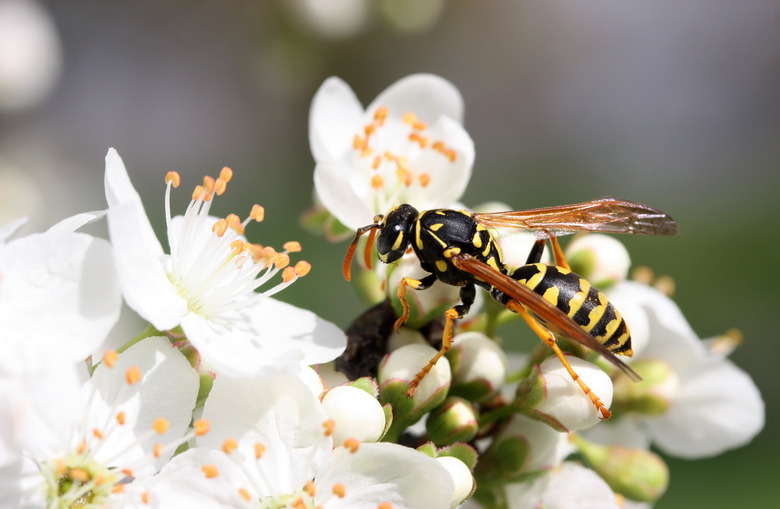How To Make Yellowjacket Attractant
We may receive a commission on purchases made from links.
Yellowjackets (Vespula spp.) and the closely related bald-faced hornets (Dolichovespula maculata) are a serious threat to humans, pets, and other animals. Aggressive and likely to sting when protecting their nests and seeking food, you can reduce the number of these wasps around your home and landscape by filling traps with a homemade yellowjacket bait. While traps won't eliminate all of the yellowjackets in the area, they help knock the population back to a more reasonable level, making it safer to enjoy the sunny days of summer.
Spring Attractants for Yellowjackets
Spring Attractants for Yellowjackets
In spring, the queens crawl out of their hiding places and begin to build their nests. She lays eggs and then the first yellowjackets to hatch and mature leave the nest to seek protein to feed the queen and the new larvae. While yellowjackets feed on both protein and flower nectar, in spring, the workers are more likely to be attracted to meat.
Among the protein sources that will attract the queens and their workers are canned pet food, raw bologna, fish, fresh chicken scraps, and heptyl butyrate, a chemical that best attracts the western yellowjacket (Vespula pensylvanica). The other common yellowjacket species, such as the German yellowjacket (Vespula germanica), prefer meat proteins. Simply add the meat scraps, pet food, or heptyl butyrate to the trap to lure the yellowjackets.
Summer and Fall Attractants
Summer and Fall Attractants
By fall, when natural protein sources may be depleted, yellowjackets look for sugary foods, including fruits, beverages, and anything left out on the picnic table, to feed the developing queens that will overwinter and start new nests when the weather warms again. Jelly, overripe fruit like peaches and bananas, fruit juices, beer, and sodas all attract yellowjackets to your patio and the wasp traps.
Homemade Yellowjacket Trap
Homemade Yellowjacket Trap
While commercially made yellowjacket traps are available, a simple trap made from a 2-liter soda bottle or similar container is easily constructed. Cut off the top third of the bottle. Add 1 cup each of apple cider vinegar and water, 1/2 cup sugar, a banana peel or piece of overripe fruit, and a teaspoon of dishwashing liquid to the bottom of the bottle. Stir well to mix and then invert the top section to make a funnel into the bottle before placing it on an upside-down 5-gallon bucket in the far corner of the garden or hanging it from a tree.
A second version also requires a 2-liter bottle and a funnel or scrap of stiff but flexible plastic. Cut a 2- to 3-inch hole in the side of the bottle about two-thirds of the way up and then roll the scrap of plastic into a funnel. Tape the funnel to hold its shape and insert it into the hole in the bottle to make a path inside. Fill the bottle one-third full using the sweet attractant, leftover marinade from soaking chicken, or equal parts of water and flat soda mixed with a few drops of dishwashing liquid.
Insert a small mesh bag containing a scrap of meat, pet food, bologna, or other homemade yellowjacket bait through the top of the bottle suspended by twine and then put the cap on the top. Place it in the far corner of the garden or hang it from a tree as far as possible from the doors and patio.
Yellowjacket Life Cycle and Traps
Yellowjacket Life Cycle and Traps
Put out the yellowjacket traps early in spring as soon as the weather warms. The overwintering queens will emerge and begin looking for nourishment. Trapping the queens before they reproduce reduces the overall number of nests and yellowjackets in the area. Empty the trap and replenish the attractant every few days to ensure you capture the maximum number of yellowjacket and bald-faced hornet queens.
Once the queens produce the first eggs and larvae followed by the worker wasps emerging from the nest, the wasp activity in the area increases through the summer and into fall. While yellowjacket traps help control the wasps near your home or business, discourage the stinging pests by minimizing food sources. Cover foods and beverages, clean up spills, put leftovers away immediately, and keep trash cans well away from doors, patios, and other places where you and your family may gather. Cover trash cans with tight-fitting lids and spray the cans and tables with a solution of 3/4 cup ammonia and 1 gallon water to help repel the stinging pests.
If you have a garden or home orchard, harvest the ripe fruits and remove fallen fruits as soon as possible to discourage foraging yellowjackets. Eliminate nests near your home and garden by carefully spraying the nest opening at night with a knock-down type of yellowjacket spray. Alternatively, if you prefer organic methods and skunks waddle through your landscape regularly, wait until after dark and pour some thinned pancake syrup near or over the ground nest. Over the next few nights, the skunks will dig up the nest and eliminate the problem.
